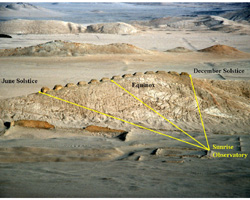
For that reason, it is not unusual to find both 'Sumerian' cubits and 'Egyptian' cubits present at the same locations.
This page looks at various archaeological sites in Peru beginning with Chankillo where 13 towers are said to have formed part of an ancient sun calendar dating to around 330BC.

This is because the Chankillo towers are designed so that the sun appears not between the spaces, but over the top of each tower, so with 13 towers, counting from the solstice at the end left hand tower, the sun would make 24 steps over the towers to return to its starting position dividing the year into 24 half-months and 12 months.
Whether the sun is viewed in between the towers or over the top of the towers depends on the number of towers.
11 pillars means a progression of 20 stages or divisions over the top of the pillars.
13 towers means a progression of 24 stages or divisions over the tops of the towers.
8 towers means a progression of 12 stages or divisions in the spaces in between the towers.
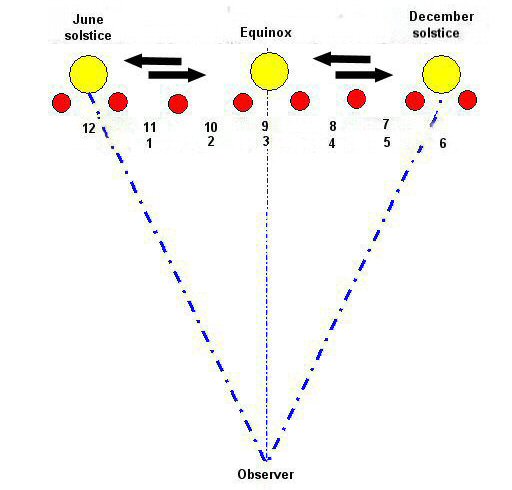
Above, The Inca are said to have set up eight towers to the east of Cusco and eight towers to the west of Cusco.
The sun throughout the year moves across the horizon and back again so with eight towers, the year would be divided into 12 months viewing the sun in the spaces in between the towers

Above, theoretical progress of the sun throughout the year,
using 8 towers gives a division of 12 months
with the sun appearing between the towers..
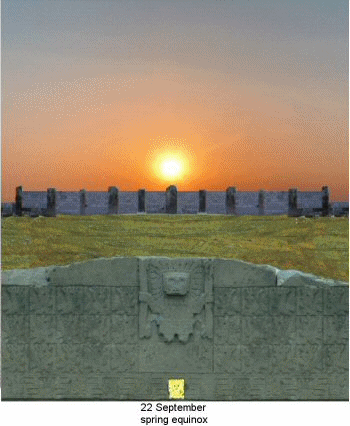
The above animation shows how at Tiwanaku in Bolivia, the year was divided into 20 months. With a calendar wall consisting of 11 pillars, the sun would set progressively over the various pillars, counting in twenties. When the sun reached the end of the pillars, it appeared to "stand still" before beginning its journey back in the opposite direction, counting in twenties in the ancient Tiwanaku calendar.
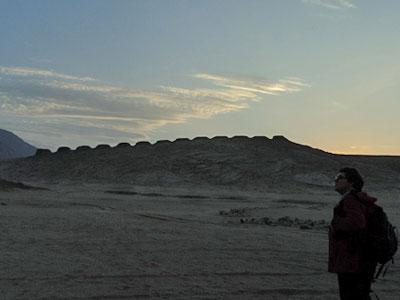
Above, the thirteen towers at Chankillo viewed from the west close to the sunrise viewing position.

Above, the sun has been photographed rising between the
Chankillo towers but the months should be viewed when the sun rises
above the towers, not between them.

Above, theoretical progress of the sun throughout the year, every second tower marks one month dividing the year into 12 months.
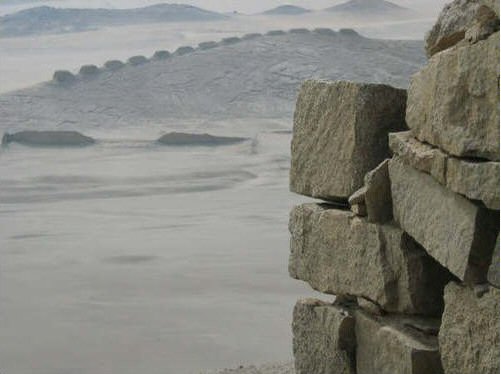
Above, view of the towers from the nearby fortified hilltop.
Because of the high position of this fort, it is clear that the solar
observations of the towers were not made from this position, but lower down on the plain.

Above, one of the Chankillo solar towers.
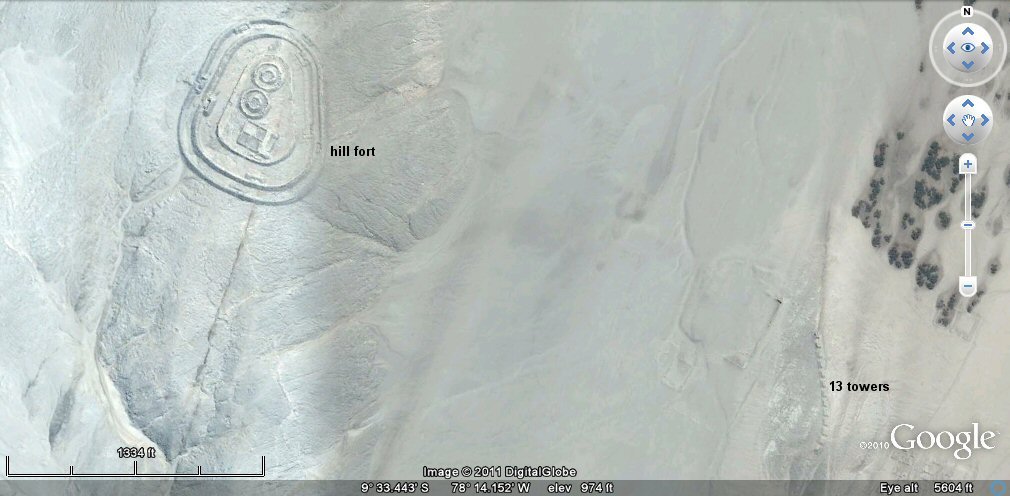
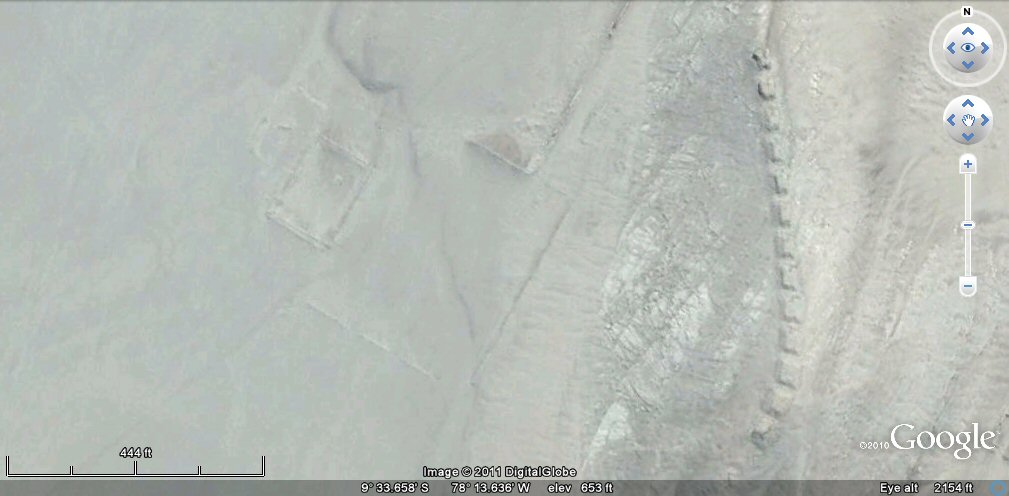
Above, the row of 13 towers, about 660ft overall length.
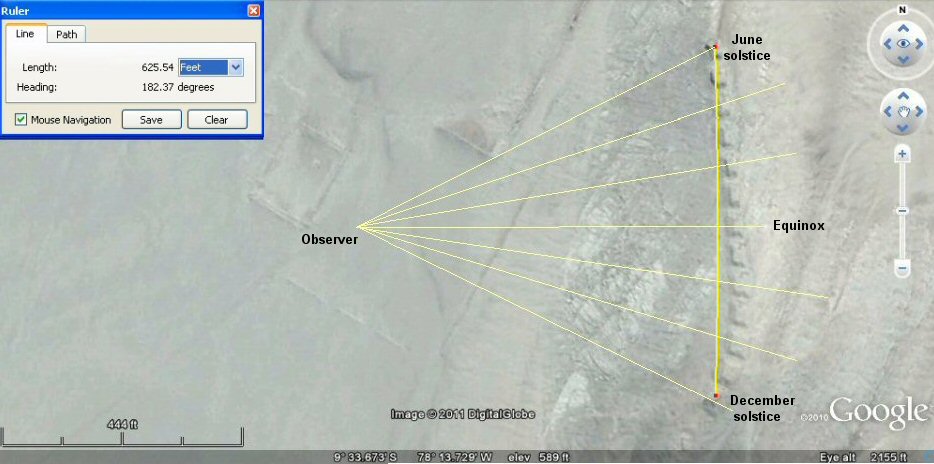
Above, the towers measure about 626ft from centre to centre of the end towers, every
second tower is one solar month on a twelve month calendar. The viewing position is about 660ft or 400 Sumerian cubits from the centre tower. The sun could also be seen setting over the towers if viewed from the east.
The Egyptian Royal cubit was 20.625" and the Sumerian measurement units were [16]
Shusi of 0.66"
Link of 12 shusi (7.92")
Foot of 20 shusi (13.2")
Cubit of 30 shusi (19.8")
Yard of 50 shusi (33.0")
Double yard of 100 shusi (66.0")
Pole of 16.5ft (15 Sumerian feet)
Furlong of 660ft (600 sumerian feet) etc.

Above, the compound measures about 330ft which is 200 Sumerian cubits on the south side and 396ft which is 240 Sumerian cubits on the west side.

Above, the smaller adjacent compound is about 165ft which would be 100 Sumerian cubits in length, or
possibly slightly larger since it appears to have two sets of walls, 172ft would be 100 Egyptian Royal Cubits for example.

Above, this compound measures 770ft which is 700 Sumerian feet.

Above, this compound measures 220ft which is 200 Sumerian feet.
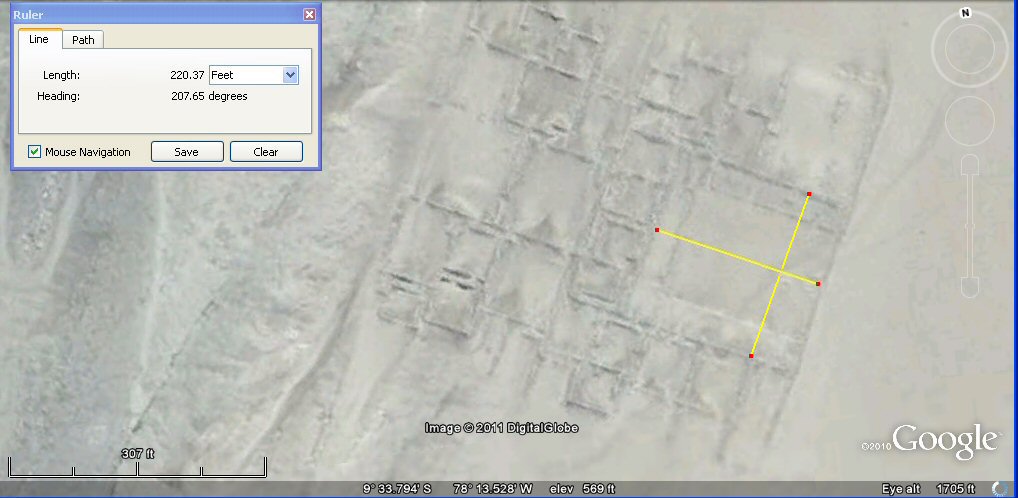
Above, this compound also measures approximately 220ft which is 200 Sumerian feet.

Above, the hill fort measures approximately 983ft from north to south.

Above, the twin inner circles are of about the same size,
50 Sumerian yards of 50 shusi for the outer ring and 50 Sumerian feet for the inner ring.

Above, the Chankillo hill fort.

Above, remains of walls at the Chankillo hill fort.
Moxeque, 1800-900BC
Moxeque es considerada una de las urbes planificadas más antiguas y más grandes de los Andes. Se inició su construcción en el año 1800 a.C. junto con la aparición de la cerámica y estuvo habitada hasta el año 900 a.C.Moxeque is considered as one of the oldest and largest planned urban complexes in the Andes. Its construction began in 1800BC along with the appearance of the first ceramics and it was inhabited until 900BC. The Initial period (1800 to 900BC), in Peru, is the period when ceramics, clothmaking as an industry and canal irrigation on a large scale began.

Above, Map showing Sechin, Moxeque and Chankillo.

Above, Moxeque.
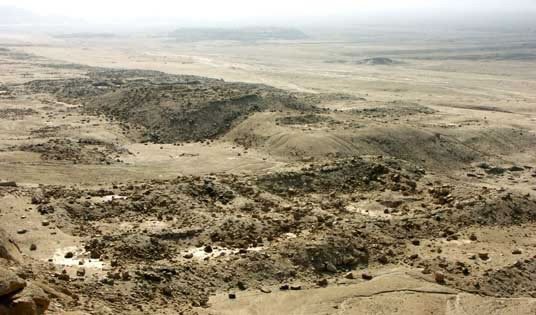
Above, Moxeque aerial view.
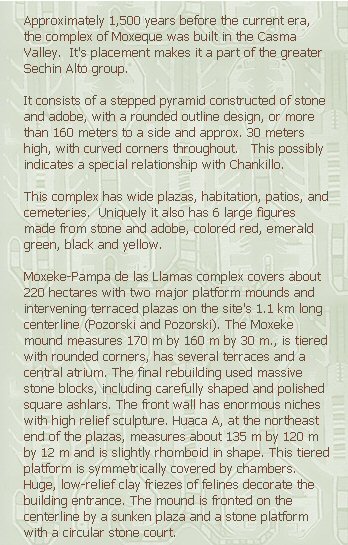
Above,
Moxeque dimensions. 160 metres is about 320 Sumerian cubits or 480 Sumerian feet.
170 x 160 x 30m is about 340 x 320 x 60 Sumerian cubits
135 x 120 x 12m is about 270 x 240 x 24 Sumerian cubits.
It may be difficult to obtain accurate figures due to the ruined conditions of the site.
Sechin, 1800-900BC

Above, this site at Sechin measures about 165ft which is 100 Sumerian cubits.

Above, the diagonal is 220ft which is 200 Sumerian feet.

Above, this width is about 172ft which is 100 Egyptian royal cubits.
A perfect square whose sides are 100 Egyptian Royal Cubits of 20.625" will have a diagonal of 200 Egyptian remen of 14.58" and the remen was a 1/5,000th part of a minute of latitude. So a diagonal of 200 remen represents half a minute of latitude or half a geographic mile. The usefulness of this arrangement was that it enable surveyors to easily set out a perfect square, since if they set out the sides in royal cubits, they could check the "squareness" by measuring the diagonal in round numbers in remen.

Above, the right hand side seems longer, 172ft would be 100 Egyptian royal cubits for comparison,
Google Earth images are given only as guidelines.

Above,
according to this report, the large mound at Sechin Alto measures about 990ft by 825ft.
It would therefore be 900 Sumerian feet by 750 Sumerian feet or 600 Sumerian cubits by 500 Sumerian cubits.
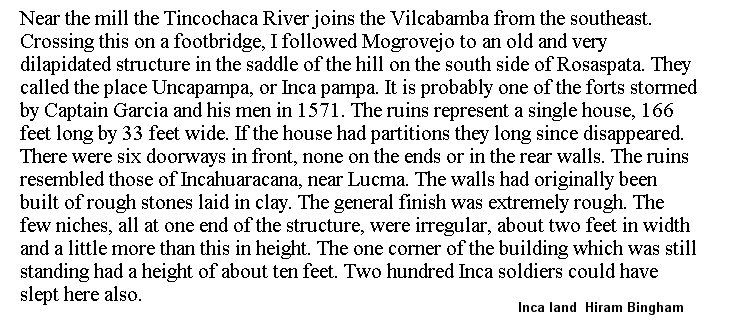
Above, measurements by Hiram Bingham of a house 166ft by 33ft, which would be 100 Sumerian
cubits by 20 Sumerian cubits.
Caral, 2627BC

Above, this complex has a frontage of about 550ft or 500 Sumerian feet

Above, this complex has a diameter of about 110ft or 100 Sumerian feet.
Google Earth images are given only as guidelines and accurate ground measurements for analysis would be useful.

Above, this complex measures about 100 Egyptian Royal Cubits west-east and 90 Egyptian Royal Cubits north-south

Above, this complex side measures about 90 Egyptian Royal Cubits.
Tucume 1000/1100-1350 AD)

Above, these plots at Tucume are each 330ft wide which is 300 Sumerian feet wide, the two together make 660ft which is one furlong or 600 Sumerian feet or 400 sumerian cubits.
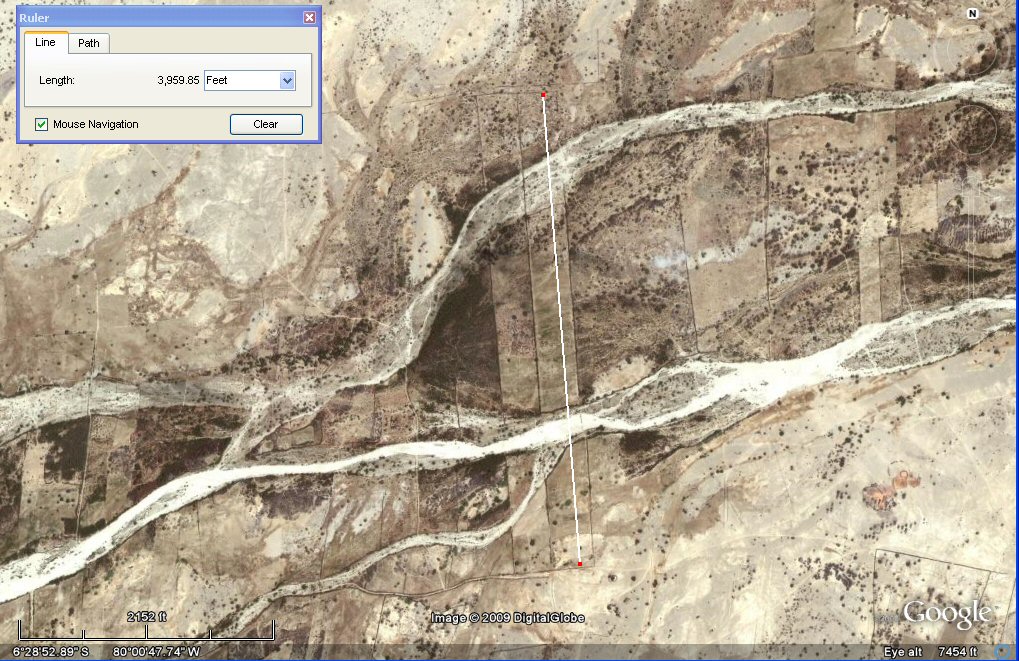
Above, the two plots at Tucume are 2400 Sumerian cubits in length.
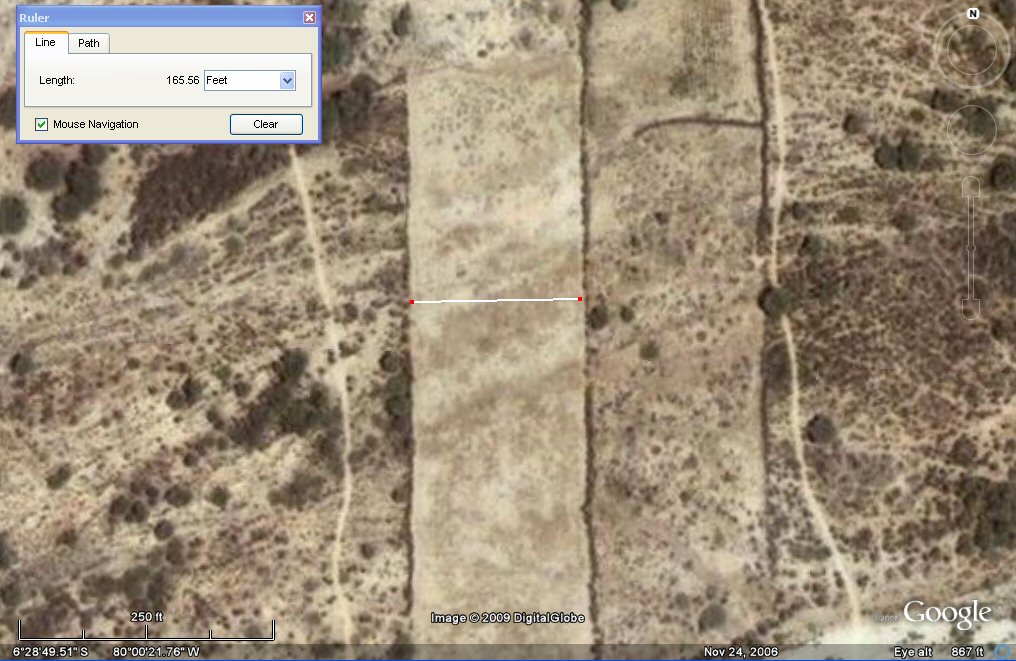
Above, this plot at Tucume is about 165ft or 100 Sumerian cubits wide.

Above, the side of this pyramid at Tucume is about 330ft which is 300 sumerian feet or 200 Sumerian cubits.

Above,
according to this report
this site at Tucume measures about 689ft by 259ft
which would therefore be 400 Egyptian royal cubits by 150 Egyptian royal cubits.
Chan Chan
The vast adobe city of Chan Chan was built by the Chimu around AD 850 and lasted until its conquest by the Inca Empire in AD 1470.
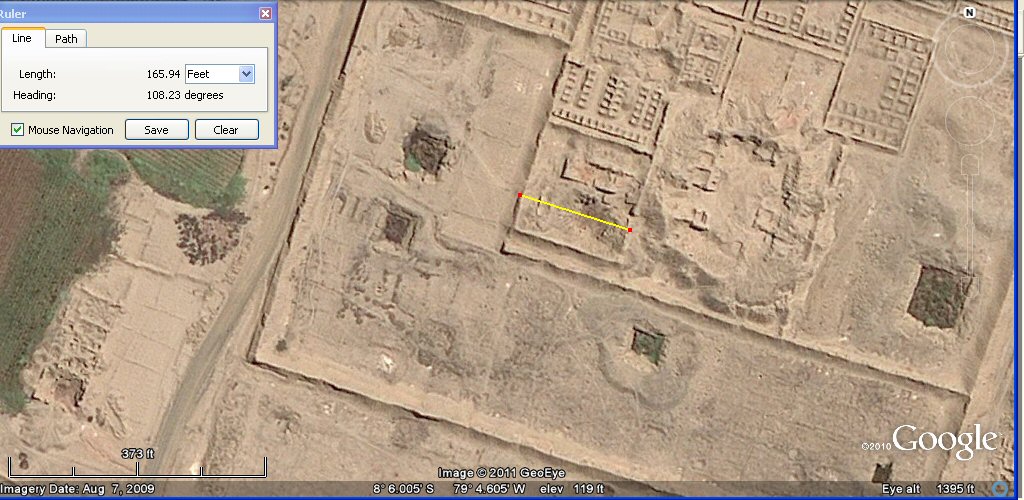
Above, courtyard 100 Sumerian cubits square.

Above, another courtyard 100 Sumerian cubits wide.

Above, courtyard about 200 by 180 Sumerian feet.
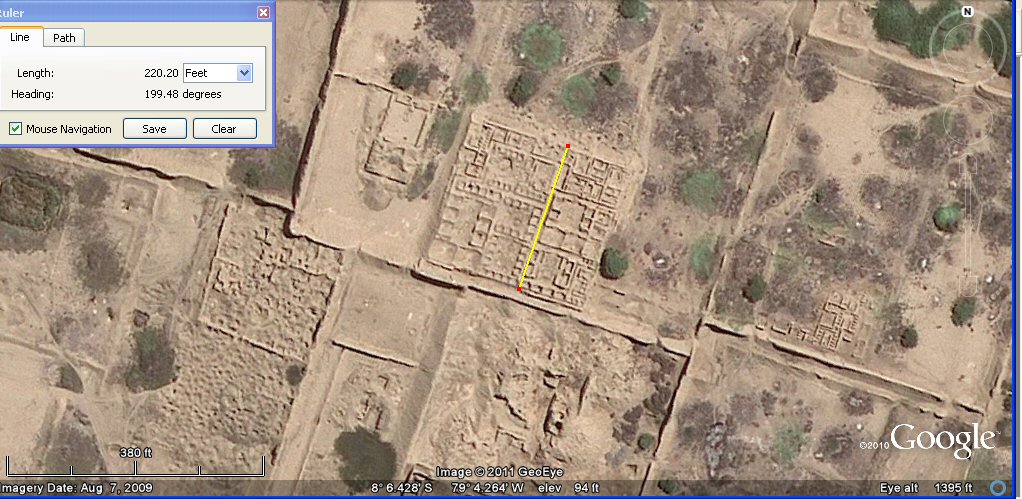
Above, 220ft is 200 Sumerian feet.

Above, 330ft is 300 Sumerian feet or 200 Sumerian cubits
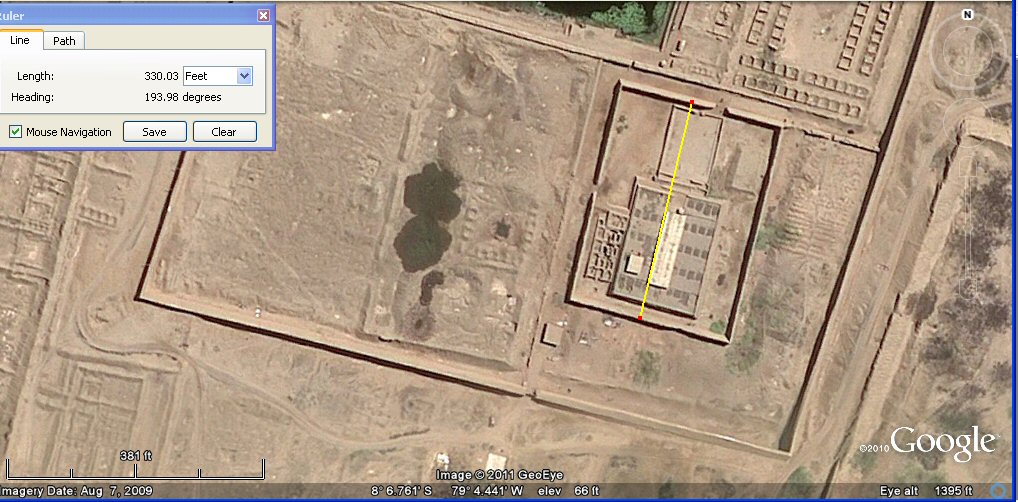
Above, another example about 330ft is 300 Sumerian feet or 200 Sumerian cubits.
Click here for Tiwanaku cubits page
Click here for combined Tiwanaku calendar and Muisca calendar page
Click here for Atlantis Stade
Click here for citadel cubits, Teotihuacan measuring unit
Click here for Chichen Itza and El Castillo cubits
J.M. Allen March 2011
webatlantis@hotmail.com